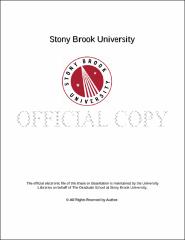| dc.identifier.uri | http://hdl.handle.net/11401/77775 | |
| dc.description.sponsorship | This work is sponsored by the Stony Brook University Graduate School in compliance with the requirements for completion of degree. | en_US |
| dc.format | Monograph | |
| dc.format.medium | Electronic Resource | en_US |
| dc.language.iso | en_US | |
| dc.publisher | The Graduate School, Stony Brook University: Stony Brook, NY. | |
| dc.type | Dissertation | |
| dcterms.abstract | Many shark populations have declined due to overexploitation and it is imperative to determine whether or not protected areas like marine reserves are an appropriate approach for shark conservation. The Caribbean reef shark (Carcharhinus perezi) is a large reef-associated predator endemic to the Western Atlantic. Belize, Central America, has implemented marine reserves as part of its national strategy for coral reef ecosystem conservation, including C.perezi. The overarching objective of this dissertation is to use Belize’s marine reserves network to investigate their effect on C.perezi populations and elucidate its ecological role. A global literature review provides evidence of positive reserve effects in sharks and rays but only from spatial comparisons of reserves and fished sites. Annual catch per unit effort and total length of C.perezi was analyzed from 2000-2013 at Glover’s Reef Marine Reserve (GRMR). This population exhibited a stable trend and broad, stable size distribution of individuals, suggesting the reserve is effective at reducing fishing pressure. Automated acoustic telemetry and baited remote underwater video (BRUV) surveys demonstrated that C.perezi of all life-stages are residential at GRMR and relative abundance is significantly higher inside marine reserves than similar fished reefs. Bulk stable isotope analysis of C.perezi white muscle collected at GRMR demonstrated that it feeds at a similar trophic level to other large predators in the system, feeds across a wide variety of habitats and that larger individuals derive more of their carbon from seagrass based food webs. There was a significant effect of reserve, habitat, and their interaction on the presence of stingrays (F. Dasyatidae) on BRUVs at two reserves and two fished reefs. Specifically, stingrays were less common on the fore-reef inside reserves. This pattern supports stingrays increasing their use of deep fore-reef habitat when C.perezi, the only common potential predator, is at low abundance. Overall and despite important data gaps, marine reserves appear effective for the conservation of residential shark species like C.perezi. This species might not exert top down control of the ecosystem due to functional redundancy and/or omnivory but there is evidence of behaviorally mediated interactions between C.perezi and stingrays. | |
| dcterms.abstract | Many shark populations have declined due to overexploitation and it is imperative to determine whether or not protected areas like marine reserves are an appropriate approach for shark conservation. The Caribbean reef shark (Carcharhinus perezi) is a large reef-associated predator endemic to the Western Atlantic. Belize, Central America, has implemented marine reserves as part of its national strategy for coral reef ecosystem conservation, including C.perezi. The overarching objective of this dissertation is to use Belize’s marine reserves network to investigate their effect on C.perezi populations and elucidate its ecological role. A global literature review provides evidence of positive reserve effects in sharks and rays but only from spatial comparisons of reserves and fished sites. Annual catch per unit effort and total length of C.perezi was analyzed from 2000-2013 at Glover’s Reef Marine Reserve (GRMR). This population exhibited a stable trend and broad, stable size distribution of individuals, suggesting the reserve is effective at reducing fishing pressure. Automated acoustic telemetry and baited remote underwater video (BRUV) surveys demonstrated that C.perezi of all life-stages are residential at GRMR and relative abundance is significantly higher inside marine reserves than similar fished reefs. Bulk stable isotope analysis of C.perezi white muscle collected at GRMR demonstrated that it feeds at a similar trophic level to other large predators in the system, feeds across a wide variety of habitats and that larger individuals derive more of their carbon from seagrass based food webs. There was a significant effect of reserve, habitat, and their interaction on the presence of stingrays (F. Dasyatidae) on BRUVs at two reserves and two fished reefs. Specifically, stingrays were less common on the fore-reef inside reserves. This pattern supports stingrays increasing their use of deep fore-reef habitat when C.perezi, the only common potential predator, is at low abundance. Overall and despite important data gaps, marine reserves appear effective for the conservation of residential shark species like C.perezi. This species might not exert top down control of the ecosystem due to functional redundancy and/or omnivory but there is evidence of behaviorally mediated interactions between C.perezi and stingrays. | |
| dcterms.available | 2017-09-20T16:53:34Z | |
| dcterms.contributor | Chapman, Demian | en_US |
| dcterms.contributor | Pikitch, Ellen | en_US |
| dcterms.contributor | Cerrato, Robert | en_US |
| dcterms.contributor | Grubbs, Ralph | en_US |
| dcterms.contributor | Heithaus, Michael. | en_US |
| dcterms.creator | Bond, Mark | |
| dcterms.dateAccepted | 2017-09-20T16:53:34Z | |
| dcterms.dateSubmitted | 2017-09-20T16:53:34Z | |
| dcterms.description | Department of Marine and Atmospheric Science. | en_US |
| dcterms.extent | 181 pg. | en_US |
| dcterms.format | Monograph | |
| dcterms.format | Application/PDF | en_US |
| dcterms.identifier | http://hdl.handle.net/11401/77775 | |
| dcterms.issued | 2015-05-01 | |
| dcterms.language | en_US | |
| dcterms.provenance | Made available in DSpace on 2017-09-20T16:53:34Z (GMT). No. of bitstreams: 1
Bond_grad.sunysb_0771E_12637.pdf: 4794872 bytes, checksum: 638ee6622b1803fd7c21c0c5f1c5c2ab (MD5)
Previous issue date: 2015 | en |
| dcterms.publisher | The Graduate School, Stony Brook University: Stony Brook, NY. | |
| dcterms.subject | Conservation biology | |
| dcterms.subject | baited remote underwater video, coral reefs, marine reserves, reef shark, stable isotopes, stingray | |
| dcterms.title | Effects of marine reserves on the relative abundance, distribution and ecology of tropical reef elasmobranchs: Caribbean reef sharks and southern stingrays | |
| dcterms.type | Dissertation | |

